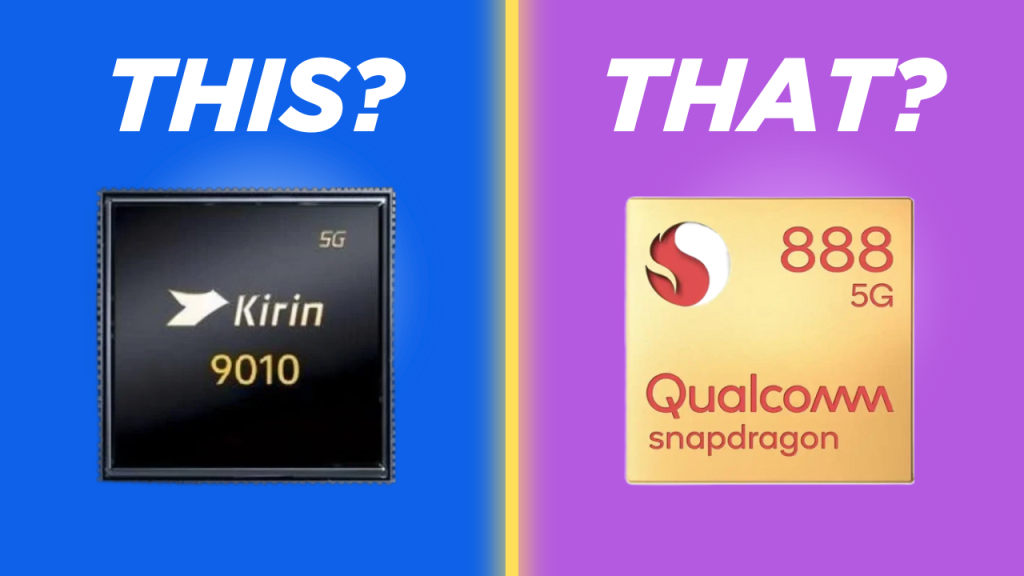The Snapdragon 8 Gen 3 beats the Kirin 9010 by a good margin in our comparison (read it here). But can Huawei’s flagship chip survive against the 3-year-old Snapdragon 888 chip?
Read this detailed comparison to understand if it’s worth spending on a Kirin 9010 or if getting a Snapdragon 888-powered phone is still a better option.
Overview
The Snapdragon 888 SoC is a powerful chip from Qualcomm. It was found in flagship phones during its early days and is now in premium mid-range phones. Huawei’s Kirin 9010, on the other hand, is said to be a flagship chip but has disappointing benchmarking numbers to put it in the flagship category.
Here’s a quick comparison table to begin with:
| Feature | Kirin 9010 | Snapdragon 888 |
| Process Node | 7nm (SMIC) | 5nm (Samsung) |
| CPU Cores | 1 x 2.3 GHz Taishan Big 3 x 2.18 GHz Taishan Mid 4 x 1.55 GHz Cortex-A510 | 1 x 2.84 GHz Cortex-X1 3 x 2.42 GHz Cortex-A78 4 x 1.8 GHz Cortex-A55 |
| GPU | Maleoon 910 @ 750 MHz | Adreno 660 @ 792 MHz |
| RAM | – | Up to 24GB LPDDR5 @ 3200 MHz |
| 5G | Yes | Yes |
| Download/Upload Speed | – | Up to 7500 Mbps/3000 Mbps |
SMIC produces the 7nm Kirin 9010 chipset for Huawei, whereas the Snapdragon 888 uses a 5nm fabrication process. Increased transistor density in Snapdragon 888 allows for lower power consumption for the same level of performance compared to the Kirin 9010.
All the cores in Snapdragon 888 run at a higher clock speed than Kirin 9010’s, which means it can better handle high processing-intensive tasks. However, other metrics, such as thread management, storage speed, and software optimization, also influence the overall performance.
Although the Adreno 660 GPU in Kirin 9010 runs at a lower clock speed than the Snapdragon 888’s, the 3DMark Wild Life Extreme benchmark results tell a different story.
Let’s now look at how these two chipsets perform on various benchmarking platforms.
Benchmarks
Kirin 9010 SoC:
- AnTuTu v10: 972,547
- Geekbench v6 (single-core): 1,446
- Geekbench v6 (multi-core): 4,524
- 3DMark Wild Life Extreme: 1,531
Snapdragon 888 SoC:
- AnTuTu 10: 892,658
- Geekbench v6 (single-core): 1,498
- Geekbench v6 (multi-core): 3,948
- 3DMark Wild Life Extreme: 1,498
The Kirin 9010 (7nm) is able to beat the Snapdragon 888 (5nm) in multiple benchmarking tests, but the difference is not significant. Keep in mind that the benchmarking tests do not reflect real-world performance.
Kirin 9010 vs Snapdragon 888: Final Thoughts
Kirin 9010 and Snapdragon 888 are high-performance mobile chipsets performing similarly on benchmarking platforms. Both can handle games and high-performance tasks; therefore, picking one becomes difficult.
Things that go in Snapdragon 888’s favor include its use of a 5nm processor node, which is better than 7nm on Kirin 9010. Another critical point to mention here is that Huawei hasn’t revealed the chip details, so many details are under the cover. However, according to multiple reports, the Kirin 9010 is nothing but a slightly modified version of the Kirin 9000s. So, based on these reasons, I’d pick the Snapdragon 888 over the Kirin 9010.
Other Popular Chip Comparisons:
1. Kirin 9010 vs Snapdragon 8 Gen 3
2. MediaTek Dimensity 7050 vs. Snapdragon 6 Gen 1
3. Snapdragon 8s Gen 3 vs Snapdragon 7+ Gen 2
4. Snapdragon 7+ Gen 3 vs. Snapdragon 8 Gen 2








